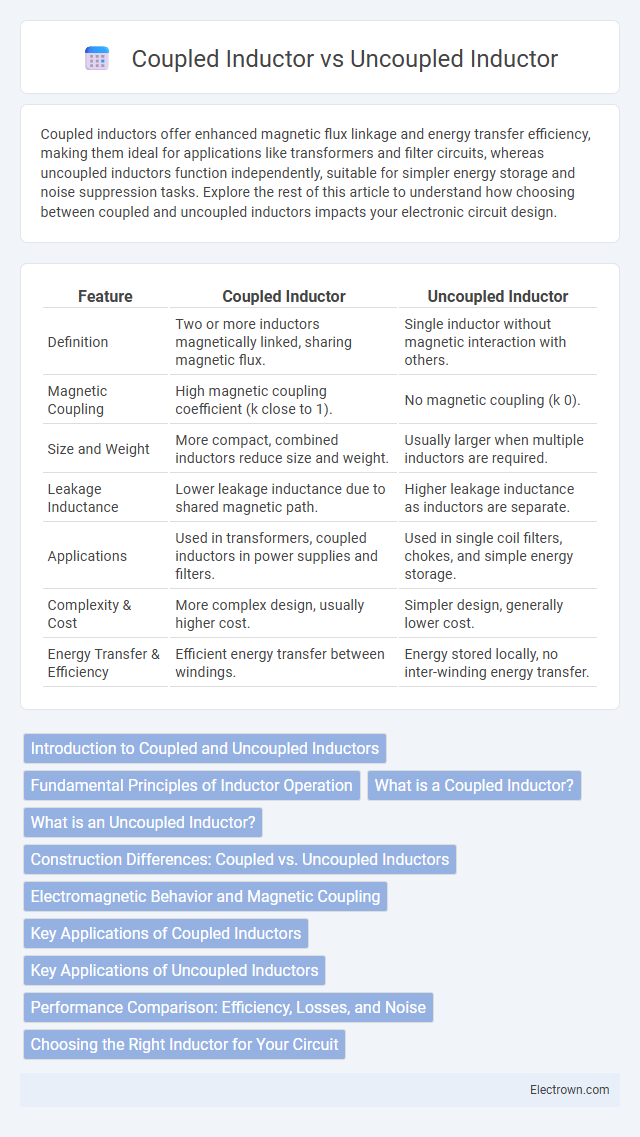Coupled inductors offer enhanced magnetic flux linkage and energy transfer efficiency, making them ideal for applications like transformers and filter circuits, whereas uncoupled inductors function independently, suitable for simpler energy storage and noise suppression tasks. Explore the rest of this article to understand how choosing between coupled and uncoupled inductors impacts your electronic circuit design.
Table of Comparison
| Feature | Coupled Inductor | Uncoupled Inductor |
|---|---|---|
| Definition | Two or more inductors magnetically linked, sharing magnetic flux. | Single inductor without magnetic interaction with others. |
| Magnetic Coupling | High magnetic coupling coefficient (k close to 1). | No magnetic coupling (k 0). |
| Size and Weight | More compact, combined inductors reduce size and weight. | Usually larger when multiple inductors are required. |
| Leakage Inductance | Lower leakage inductance due to shared magnetic path. | Higher leakage inductance as inductors are separate. |
| Applications | Used in transformers, coupled inductors in power supplies and filters. | Used in single coil filters, chokes, and simple energy storage. |
| Complexity & Cost | More complex design, usually higher cost. | Simpler design, generally lower cost. |
| Energy Transfer & Efficiency | Efficient energy transfer between windings. | Energy stored locally, no inter-winding energy transfer. |
Introduction to Coupled and Uncoupled Inductors
Coupled inductors consist of two or more inductors magnetically linked through a shared core, enabling energy transfer and mutual inductance, which enhances circuit performance in transformers and filters. Uncoupled inductors operate independently without magnetic interaction, providing isolated inductance for applications requiring minimal interference and precise inductance control. Understanding the distinction between coupled and uncoupled inductors helps optimize your circuit design for efficiency and electromagnetic compatibility.
Fundamental Principles of Inductor Operation
Coupled inductors operate based on magnetic flux linkage between two or more windings, enabling energy transfer through mutual inductance, which enhances efficiency in power conversion and filtering applications. Uncoupled inductors function independently with no magnetic interaction, relying solely on self-inductance to store and release energy in electromagnetic fields. The fundamental principle of inductor operation involves the inductance property, where a time-varying current induces a voltage opposing the change, governed by Faraday's law of electromagnetic induction.
What is a Coupled Inductor?
A coupled inductor consists of two or more inductors wound on a shared magnetic core, allowing magnetic flux to link between coils and enabling energy transfer through mutual inductance. This design improves efficiency in power conversion circuits by reducing leakage inductance and electromagnetic interference compared to uncoupled inductors, which operate independently without magnetic coupling. Understanding the behavior of coupled inductors can enhance your ability to optimize circuit performance in applications like transformers, DC-DC converters, and noise filters.
What is an Uncoupled Inductor?
An uncoupled inductor consists of a single coil wound around a magnetic core, designed to store energy independently without magnetic interaction with other coils. Unlike coupled inductors, which share magnetic flux and can influence each other's inductance, uncoupled inductors prevent energy transfer between circuits, ensuring isolation. Your circuit benefits from uncoupled inductors when minimal electromagnetic interference and independent current control are required.
Construction Differences: Coupled vs. Uncoupled Inductors
Coupled inductors consist of two or more coils wound on a shared magnetic core, enabling magnetic flux linkage and energy transfer between windings, whereas uncoupled inductors feature individual coils with separate cores, preventing mutual inductance. The shared core in coupled inductors reduces leakage inductance and enhances efficiency in applications like transformers or coupled filter circuits. Your choice depends on whether magnetic coupling is necessary for your circuit's performance and compactness requirements.
Electromagnetic Behavior and Magnetic Coupling
Coupled inductors exhibit strong magnetic coupling, allowing energy transfer between coils through shared magnetic flux, which enhances performance in filters and transformers. Uncoupled inductors operate independently with minimal mutual inductance, limiting interaction and reducing interference in circuits. Your choice between the two impacts electromagnetic behavior significantly, affecting efficiency, noise reduction, and signal integrity in electronic designs.
Key Applications of Coupled Inductors
Coupled inductors are essential in applications requiring efficient energy transfer and reduced electromagnetic interference, such as in flyback converters, push-pull converters, and resonant circuits. Their magnetic coupling allows for improved performance in power supplies by minimizing leakage inductance and enhancing voltage regulation. These inductors are also widely used in filter circuits and transformers within switched-mode power supplies to optimize size and efficiency.
Key Applications of Uncoupled Inductors
Uncoupled inductors are primarily used in applications requiring independent control of magnetic fields, such as RF circuits, power filters, and isolation transformers, where minimal mutual interference is crucial. Their design enables stable inductance and predictable performance despite varying current conditions, making them ideal for high-frequency and precision circuits. Understanding the key applications of uncoupled inductors helps you select the right component for minimizing crosstalk and maintaining signal integrity in sensitive electronic systems.
Performance Comparison: Efficiency, Losses, and Noise
Coupled inductors typically offer higher efficiency and reduced losses compared to uncoupled inductors due to magnetic flux sharing and lower leakage inductance, which improves energy transfer in power conversion applications. Noise generation is also minimized in coupled inductors because of better electromagnetic interference (EMI) management, leading to quieter circuit operation. Understanding these performance differences helps you select the ideal inductor type that balances efficiency, thermal performance, and noise requirements for your specific design.
Choosing the Right Inductor for Your Circuit
Choosing the right inductor for your circuit depends on the application requirements such as size, efficiency, and electromagnetic interference (EMI). Coupled inductors offer advantages in power conversion circuits by providing mutual inductance, improving energy transfer, and reducing ripple current compared to uncoupled inductors, which are simpler but less efficient. Consider factors like coupling coefficient, inductance value, and current rating to optimize performance and minimize losses in power supply, filter, or signal processing applications.
Coupled inductor vs uncoupled inductor Infographic

 electrown.com
electrown.com